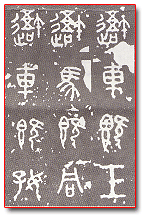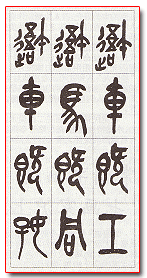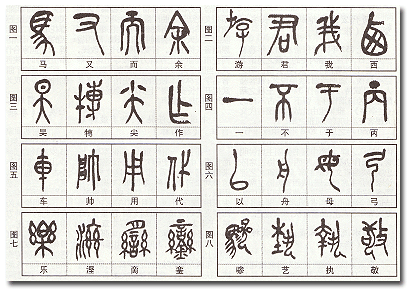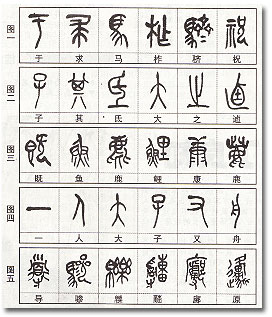"Stone Drum Inscriptions" (Figure 1 is a partial rubbing) is the earliest stone inscription in my country. It is carved on ten drum-shaped stones, hence its name. Each stone has a four-character poem, which is about the hunting of the king of Qin, so "Shigu Wen" is also called "Hunting Jie" text. The original stone is about three feet high and about two feet in diameter. It has been severely damaged by war and fire, and corroded by wind and rain, so it is quite wet. One of the stones was chiseled into a mortar in the Song Dynasty, and the other stone does not have a word left. According to Guo Moruo's statistics, "Shiguwen" has 465 complete characters. The lines of "Shiguwen" are more even and rounded than those of bronze inscriptions. The glyph structure is simpler than that of oracle bone inscriptions and bronze inscriptions. It is neat and slightly rectangular. The parallel lines are mostly arranged and decorated, rigorous and dense. The pen is round, strong and straight, the strokes are strong and dignified, and the word spacing is , the line spacing is wide and balanced, as sparse as the stars and moon in the clear sky, the characters are larger than an inch, the charm is ancient, powerful, simple and natural. It has been highly praised by everyone in the past dynasties and is an excellent model for starting to use seal script. "Essential Treatise on Seals" written by Zhu Jian of the Ming Dynasty says: "Shigu Wen is the first seal script in ancient and modern times."

In the thousands of years of calligraphy history, Wu Changshuo was the one who studied the Shiguwen the most, the most deeply and the most uniquely. Anyone who comments on Wu Changshuo must mention his "Stone Drum Essays". "Stone Drum Prose" fulfilled Wu Changshuo, and in turn, Wu Changshuo also promoted the artistic value of "Stone Drum Prose". From the performance point of view, Wu Changshuo's "Shiguwen" appears in the form of copying, but few people look at his "Shiguwen" from the perspective of appreciating copying. It should be said that Wu Changshuo's "Shiguwen" is a well-founded creation, which reflects Wu Changshuo's unique understanding of "Shiguwen". It is better to say creation than creation. Picture 2 was made by Wu Changshuo when he was 75 years old. It has a very different appearance from the original version of "Shigu Wen". It has both a classical form and an original look.

This is specifically reflected in several aspects: the font shape has changed from the slightly rectangular shape of the original version to a rectangular shape, with the length-to-width ratio close to the golden section, which is the best structural form; the lines have changed from the smooth and solid shape of the original version to a flowing and interesting style of writing. Dynamic, although the lines are round and solid, they are not hasty or slippery. They are all solid seal lines, with a sense of fragmentation and a sense of gold and stone; the structure has changed from the original straight posture to an uneven posture, and the words are flying and ready to come out. ; The division of space breaks the balance, and it can be sparse and airtight; the brush used is old and powerful, and all the brushstrokes can be used together, full of domineering spirit; the ink used has the distinction of thick, dry and moist. This is Wu Changshuo's successful attempt to use the past to create the present. Seal script is a static form, but Wu Changshuo's ability to make seal script have a sense of flying and lyrical meaning is truly admired by future generations.
This lecture is mainly about the analysis of strokes. However, the beginning and end of the strokes in "Shigu Wen" are very distinctive and critical, so the following will first introduce the writing method of the beginning and end of the strokes. In Wu Changshuo's "Stone Drum Essay", the starting and ending of writing are all natural starting and lifting, and there are few deliberate reverse movements. It is not difficult to see from the characters listed in Figure 1. Generally speaking, the arc lines in seal script can be written in one stroke or in two strokes. The right half of the "U"-shaped line in the character "Yu" is restarted, which reflects Wu Changshuo's natural writing style. Regarding this point, there are many criticisms in Ma Zonghuo's "Xiao Yue Lou Bi Tan". He believes that Wu Changshuo used the method of painting Chinese cabbage to write books, and the seal writing method was wiped out and the village spirit was full of paper. The end of the stroke naturally reveals the edge, such as the characters "you", "jun", and "wo" in the second middle. Sometimes it forms a suspended stroke, such as the strokes in the upper right half of the character "西".
1 o'clock Most of the dots in Wu Changshuo's "Stone Drum Inscriptions" are strong and strong, absorbing the characteristics of bronze inscriptions and having a decorative effect, such as the second character in Figure 3; some have a balancing effect, such as the first character; some dots have a special function and have the meaning of running script. Make the glyphs appear abnormal, such as the dots in the characters "jian" and "zuo".
2. Horizontal Each horizontal stroke has its own style, and the writing process does not pass through them in one go. Instead, there are many lifting and pressing movements to produce rhythm changes, such as the words "一" and "不" in Figure 4; when two horizontal strokes appear at the same time, through The length and thickness are changed to avoid similarity, such as the character "Yu"; sometimes the horizontal lines are changed into dots by absorbing the characteristics of bronze inscriptions, such as the character "C". vertical. In Wu Changshuo's seal script, vertical columns play a role in supporting glyphs, such as the character "车" in Figure 5. When multiple vertical lines appear, avoid the same by changing the weight and curvature, such as the words "handsome", "yong" and "generation".
3. Arc Arc is an important stroke in seal script, which embodies the meaning of circle. As shown in Figure 6, it may be curved outward or inward, or twists and turns, or twists and turns, etc., with graceful and graceful shapes.
4. Decorative strokes There are two types of decorative strokes in Wu Changshuo's "Shiguwen". One is a pattern-like form formed by stacked circles, as shown in Figure 7 for each character; the other type of decorative strokes is a "small" drawn in the writing of some characters. "Tail" is very interesting, as shown in Figure 8. The latter was used skillfully by Wu Changshuo in his creations, but later scholars such as Deng Sanmu and others showed artificiality and had the disadvantage of dragging the tail too much, which turned into a habit.

This lecture mainly analyzes the use of ink and traditional and simplified Chinese in "Shiguwen" written by Wu Changshuo.
1. Use ink The original version of "Shigu Wen" is a stone engraving, so the method of using ink is unknown. The "Shiguwen" written by Wu Changshuo is full of flesh and blood. Although most of the ink is thick and thick, there are subtle differences in movement. There are three main types: one is thick ink and the brush is bold, like the characters in Figure 1; the second is thin ink, like the characters in Figure 2; the third is thick and thin, like the characters in Figure 3. The three together constitute rich changes in calligraphy.
2. Traditional and simplified processing The treatment of traditional and simplified texts in Wu Changshuo's "Shigu Wen" can be summarized as the eight-character principle of "seeing the big from the small, deleting the complex and making it simple". In layman's terms, characters with few strokes should not be too small and lax; characters with many strokes should not be too bloated. For example, although the characters in Figure 4 have only a few strokes, they are not scattered; while in Figure 5, although the characters have many strokes and dense knots, they are generally dense and dense without any obstruction, which reflects Wu Changshuo's superb processing method.









